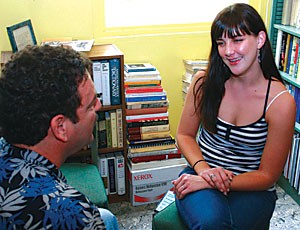Departments across campus are failing to meet the recommended number of advisers, said UA officials.
Eva Monnier, one of two political science advisers, left the UA on July 27, leaving Pamela Coonan as the only academic adviser for the department.
Coonan has put much of her usual paperwork aside in order to help out more students in Monnier’s absence, said William Dixon, the head of the political science department.
“”There is usually a line when I go to see my adviser,”” said Byron Farley, a political science senior. “”In order to handle the volume of students, I think they should have at least one more.””
The problem is echoed across campus, and students said the number of students per adviser is inadequate.
“”Having gone to a private university before, it is an utter farce to have as few advisers as we do compared the number of students there are,”” said Megan Strang, a senior majoring in political science and German studies.
Roxie Catts, co-chair of the Academic Advising Task Force, said the adviser-to-student ratio should be 1-to-400, while the adviser-to-undeclared-student ratio should be 1-to-300.
Considering these stipulations, the UA has not reached this goal, Catts said.
Political science is the second-largest major at the UA behind psychology, with more than 1,200 students in the department.
The political science department still won’t meet the recommended ratio even with a recently hired adviser, Michael Greeley, who is expected to begin Sept. 20, Dixon said.
The psychology department has four full-time advisers servicing 2,000 students.
“”The English department has a little over 1,200 students, 850 majors and a few hundred minors,”” said Bridget Radcliff, the English department’s only full-time adviser.
The question of how many advisers there should be to students was addressed nine years ago, when Mike Gottfredson, then vice president for undergraduate education, wrote a paper titled “”Student Retention: A Culture of Responsibility.”” In his paper, Gottfredson discussed ways for the UA to improve retention, one of them being to focus on the advising departments, Catts said.
In 2000, the Academic Advising Task Force was created to analyze the problem more closely.
The task force broke into subcommittees, which studied issues such as advising definitions and current delivery models, retention, undeclared students, transfer students, specialized advising – such as pre-health and pre-law – inter-relationship of academic advising and counseling and technology in academic advising, Catts said.
The final report contained 36 recommendations to improve and strengthen academic advising, including the adviser-student ratio and one faculty adviser for every 25 students.
“”We aren’t at the top of the mountain yet, but we have added 40 professional advising positions over the past 5 years, which has gone a long way towards elevating advising services for undergraduate students,”” Catts said.
Kelly McFall, a political science junior, said she thinks there is very little recognition between the students and the advisers because of the ratios.
“”I think it is ridiculous. Every time I have gone to see my adviser I have to remind her of who I am and that I am, in fact, a political science major,”” McFall said. “”It is unfair to both the advisers to have so many students they have to keep up with as well as to the students who don’t get the attention they deserve.””









